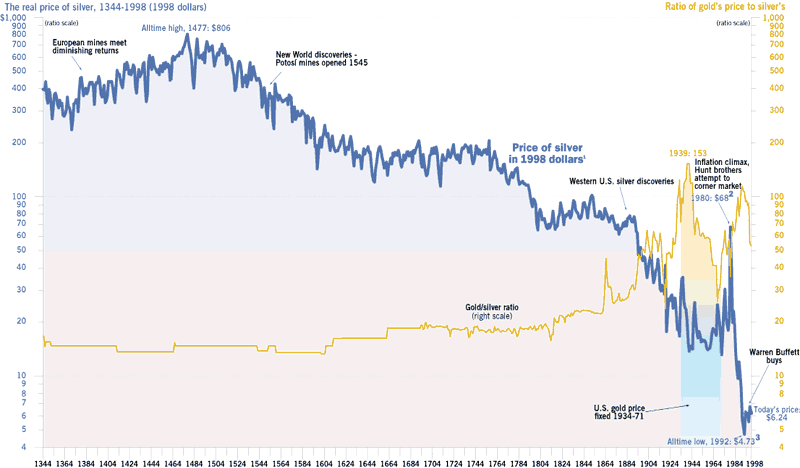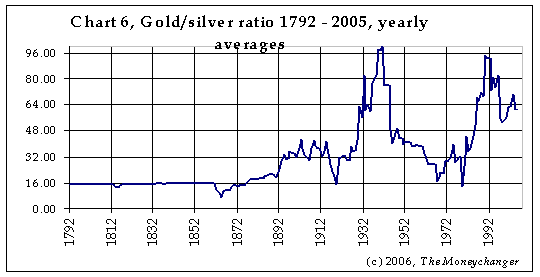The Gold:Silver Ratio
September 12, 2010
When I talk about a gold standard throughout history, I also mean gold-and-silver standards, and even monetary systems which were 95%+ silver, as was the case in places like China.
In practice, most day-to-day transactions were done with silver coins. Gold was much too valuable for small transactions, although very handy for large commercial transactions. An ounce of gold today is worth $1,250. When was the last time you carried a $1000 bill? We don’t even make them anymore. There’s a $100 bill, which is actually quite popular worldwide, but hardly used in the U.S. Our largest common bill, for daily use in legal transactions, is a $20 bill. If you were going to buy a house, you might want to use two hundred one-ounce gold coins, weighing about 14 lbs, instead of 3000 oz. of silver, which weighs about 210 lbs. However, if you were going to buy some socks, you wouldn’t want to pay with a one-ounce gold coin or even a tiny tenth-ounce coin.
This problem — of gold’s excessively high value for small transactions — was resolved through the widespread use of gold-linked paper bills. You could use a $1 bill instead of a 1/20th oz. (or 1/1000th oz.) gold coin. Thus, people didn’t need silver anymore. Britain officially went to “monometallism” in 1816, and most countries followed toward the end of the 19th century.
For most of human history, silver has traded around 12-16 oz. of silver per 1 oz. of gold. This ratio changed slowly. It didn’t bounce around, 12:1 one month and 15:1 the next month. For example, in 1789 U.S. Congress declared that the official silver:gold ratio would be 15:1, reflecting a market price of about that ratio. Over a few decades, the actual market price drifted closer to 16:1, so to reflect this, Congress changed the official ratio to 16:1 in 1835. This was the only change in the official gold/silver ratio until silver was effectively demonetized in the 1870s.
You can go back to historical times, and find that this ratio is about the same. Plato mentions a 12:1 ratio, and at the death of Alexander the Great it was 12.5:1. During later Roman times, it was 15:1. This still seems like it varies a fair amount. But this is over several centuries. For any one person’s lifetime, the ratio would be very close. It might drift from 15:1 to 16:1, or from 12:1 to 12.5:1. In other words, practically unchanged.
Thus, gold and silver were practically the same, just like $1 bills and $20 bills.


The big change came in the 1870s, the “demonetization of silver.” This was apparently a natural market (human) phenomenon, not a government edict, although governments soon reflected market reality in their official policy, which in turn accelerated the process. Bimetallism had long had minor but irritating problems with the slight variation in the gold/silver ratio. The advancement of the gold-linked-paper system, and payment by bank transfer and so forth, had eliminated the need for the use of silver coins as small-value money. You could use a $1 bill instead. In effect, silver was no longer used as a “monetary commodity” and became more like an industrial commodity, although one with some remaining monetary characteristics. From the mid-1870s onward, silver begins to vary wildly in value compared to gold, for the first time in history.
Silver coins were still used, but they became “token” coins, with a commodity value less than their monetary value. A $0.25 coin (quarter) was valuable in the 1920s, 1930s or 1940s primarily because four of them would make a dollar, and the dollar was then worth 1/20th oz. of gold, or 1/35th after 1933.
The point is, when I talk about a “gold standard” I also include within that gold and silver bimetallism, and also systems which were primarily silver-based. Until the 1870s, they were effectively the same.

